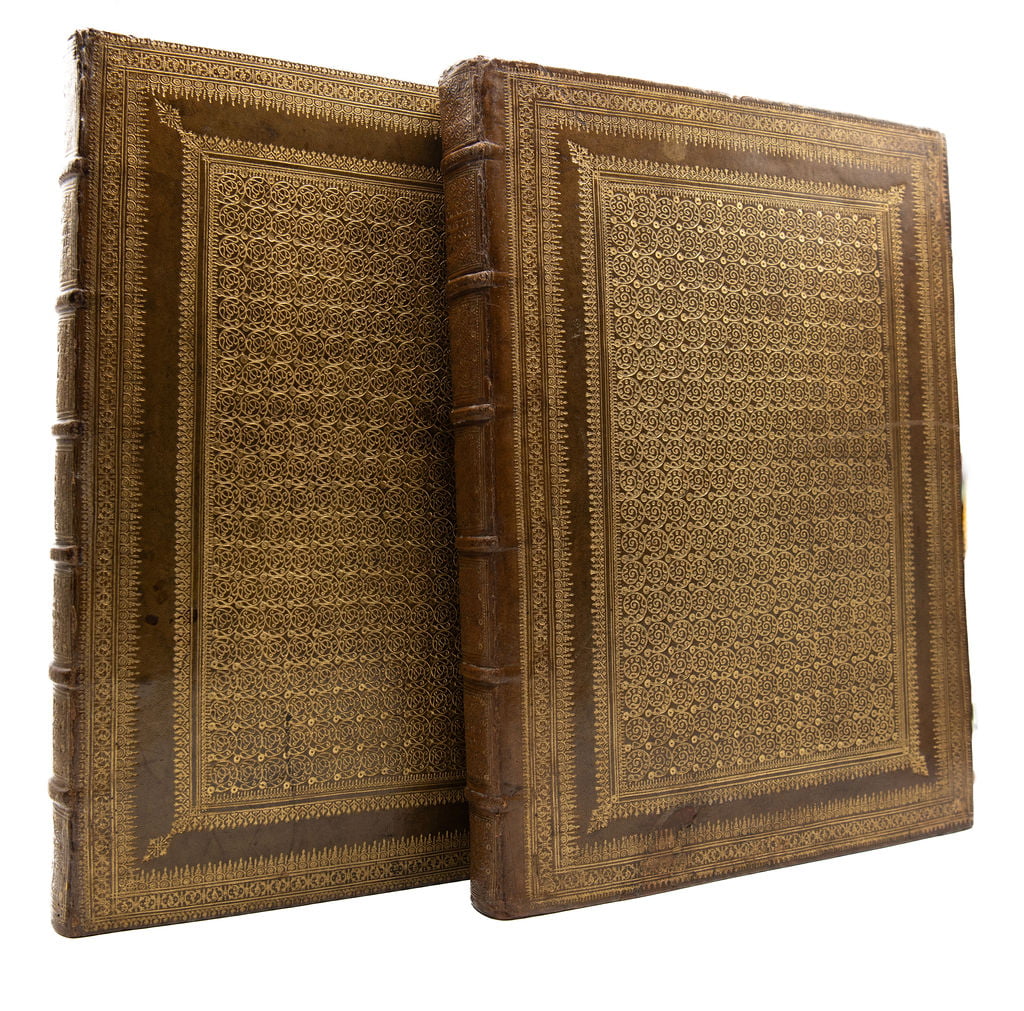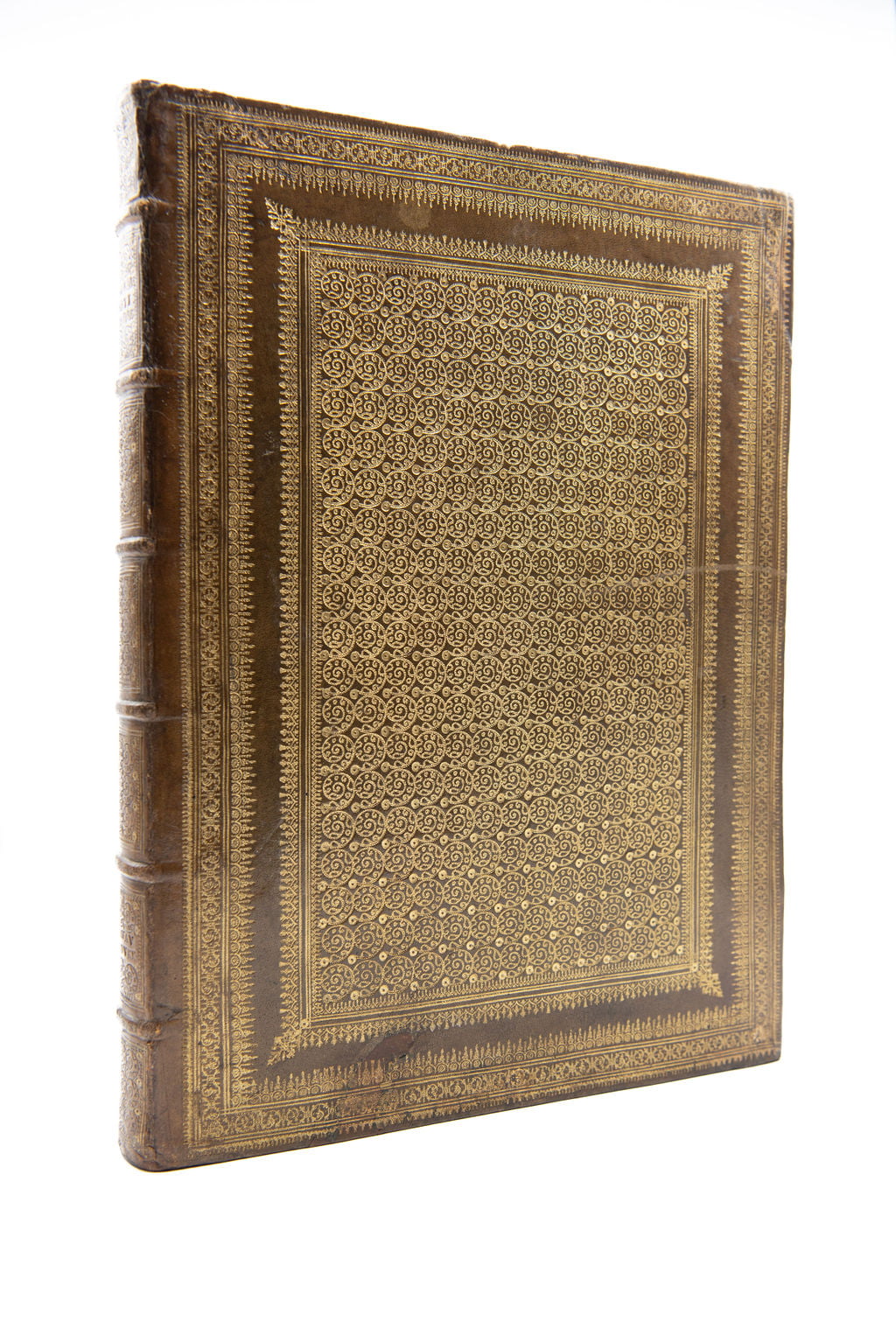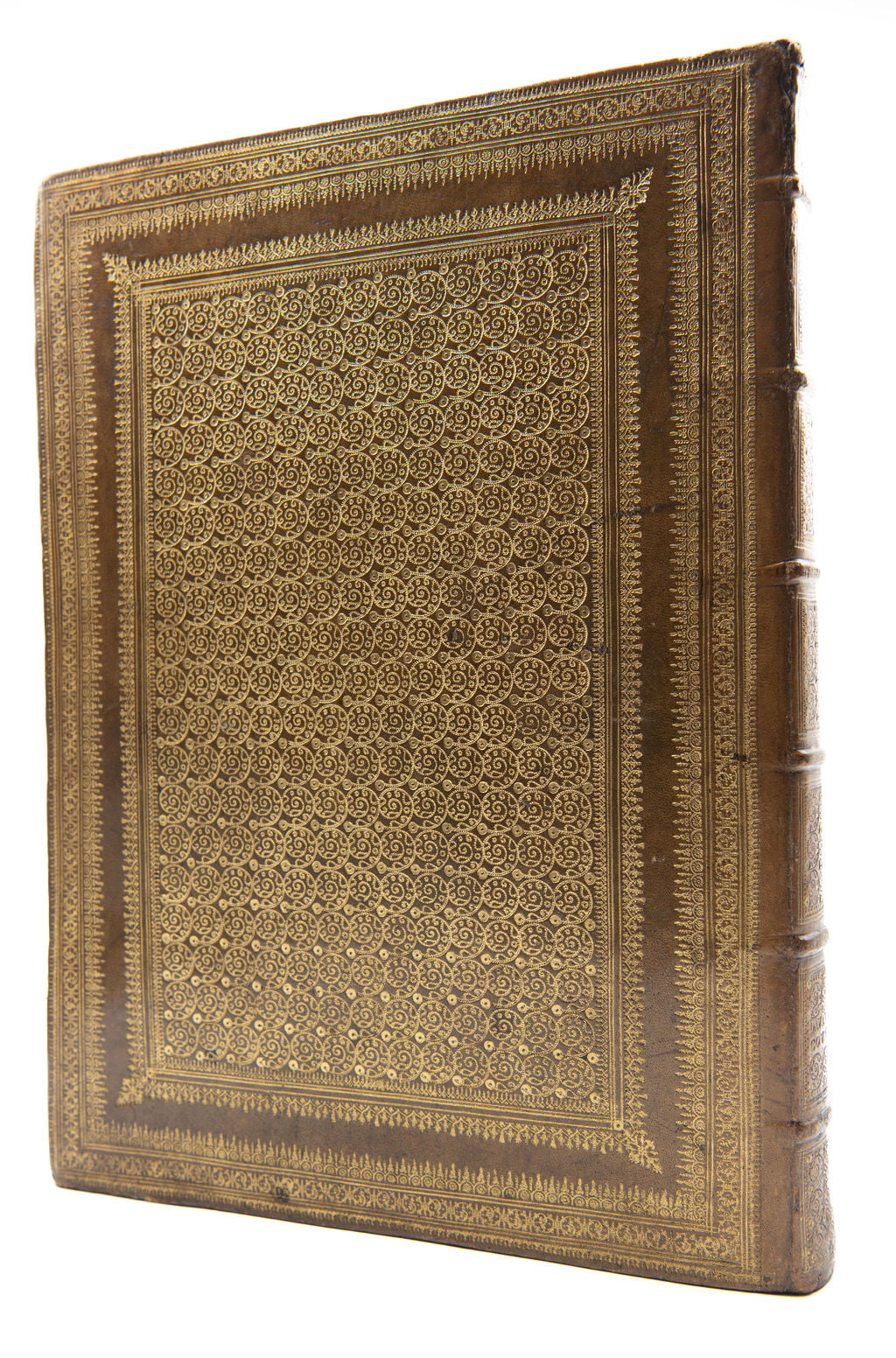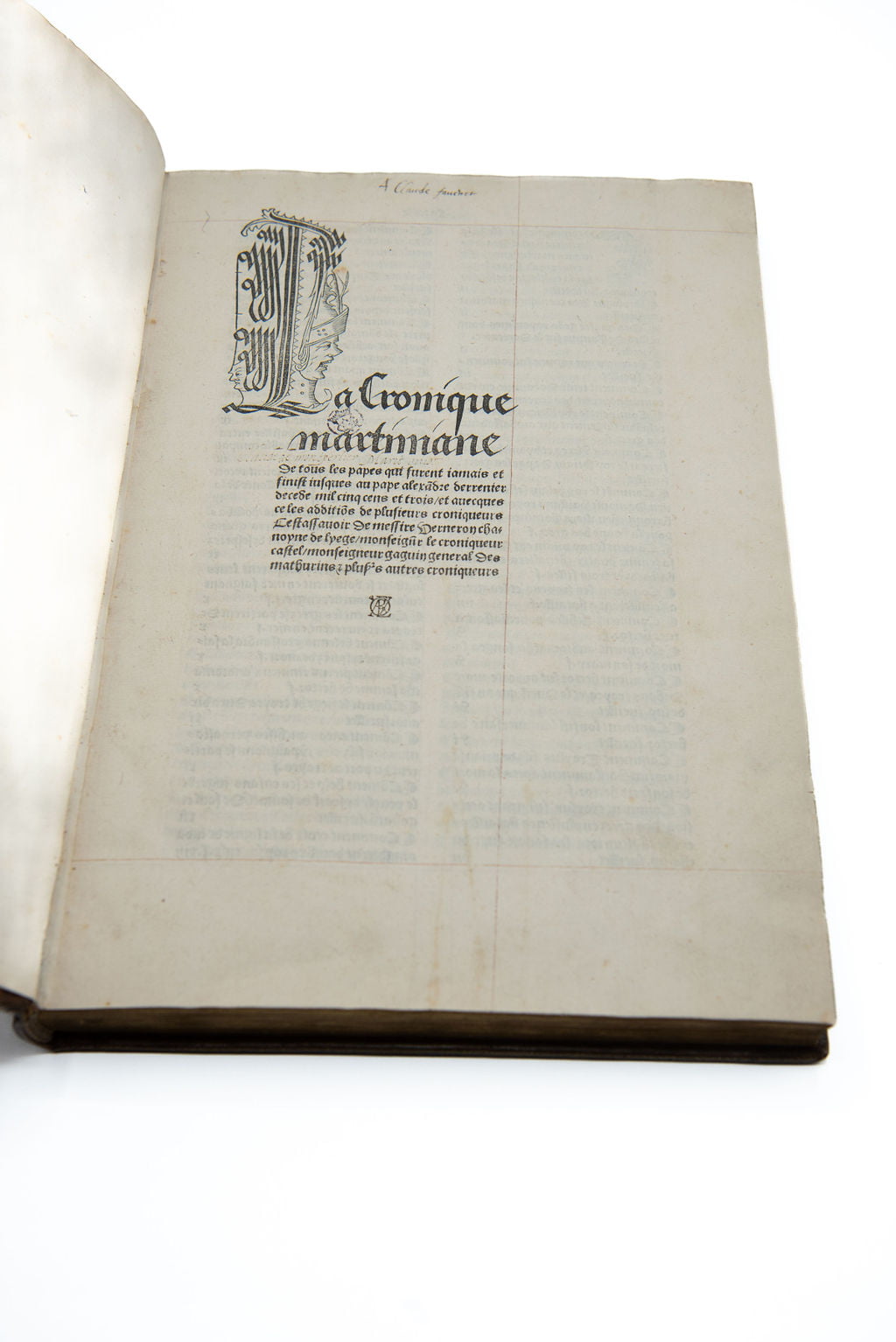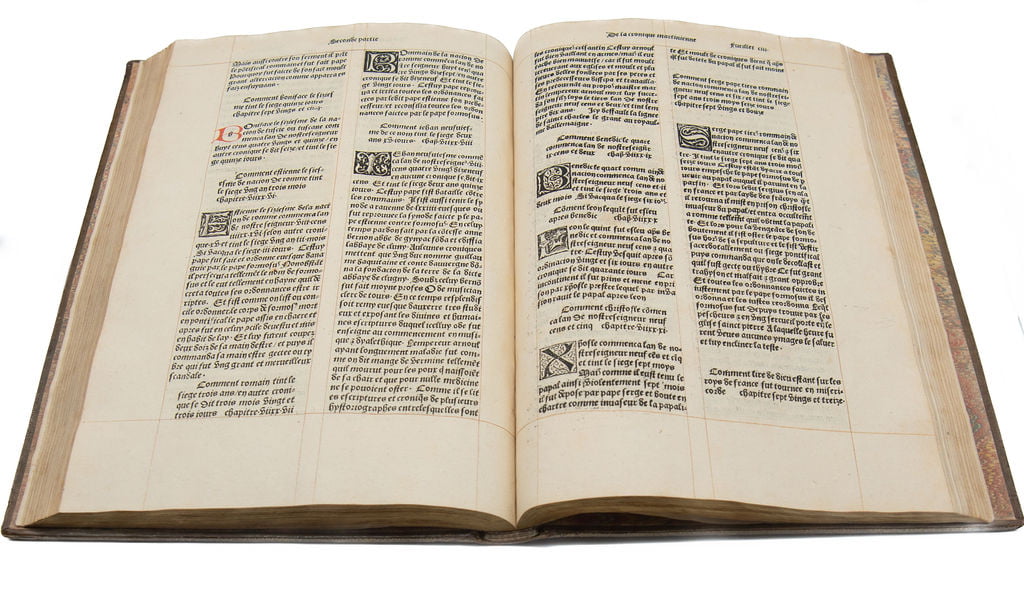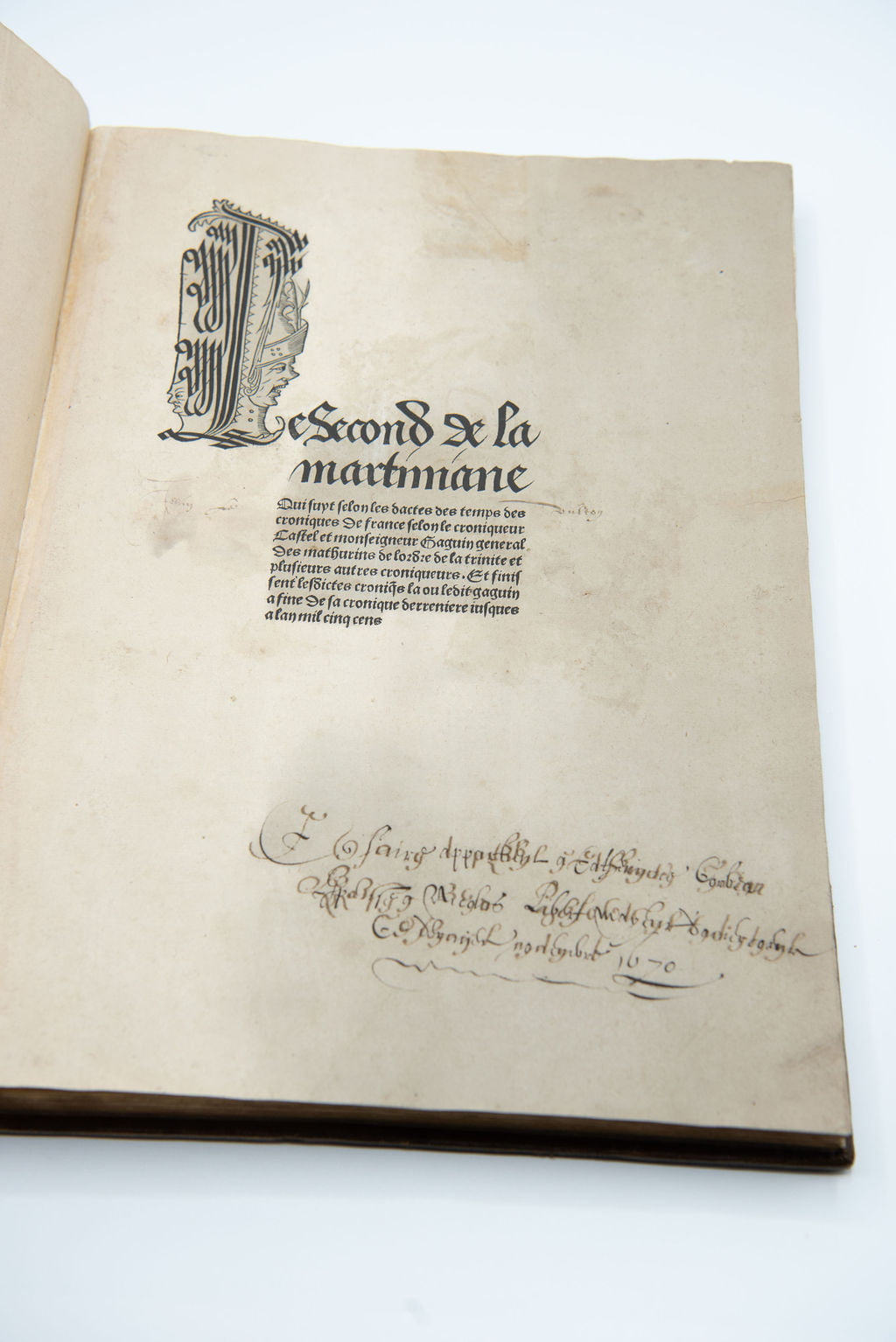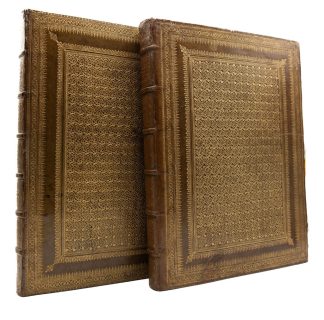MARTINUS Strepus
ATTRIBUTED TO FLORMOND BADIER
La Cronique martiniane de tous les papes qui furent iamais et finist iusques au pape Alexa[n]dre derrenier decede mil cinq cens et trios, et avecques ce les additio[n]s de plusiers croniqueurs
Paris, [?Couteau for] A. Verard, [c. 1503]£32,500.00
FIRST EDITION. 2 vols, folio. ff. (vi) CLXXXII; (viii) CCLI-CCCCII [but complete, cf. Brunet]. Double column, lettre Bâtarde. Vol I: Rubricated, 4, 6, and 8 line initials in red and red and blue, pages ruled in red, pretty woodcut initials, many white on black in several series, intricate anthropomorphic woodcut initial ‘L’ on title. Narrow oil stain affecting margins of two leaves and text of last leaf, a few minor repairs to gutters not affecting text, the odd oil spot. Vol II: Calligraphic and anthropomorphic initials in several styles, large woodcut printer’s device at end. Neat old repair to outer margin of t-p, not touching text, four leaves with repairs at gutter, last leaf laid down and outer margin restored, the odd minor or marginal spot, occasional very small wormtracks (just touching one or two letters of text), light small marginal dampstain, two leaves at end repaired at foredge. Very good clean, wide margined copies, vol II even a little wider, in matching French crushed olive morocco richly gilt, MOST PROBABLY A VERY FINE EXAMPLE OF THE WORK OF FLORIMOND BADIER, c. 1620, covers and spines with repeating geometric pattern of gilt swirls and sequins, pointillés within gilt-tooled frames, fleurons at corners, spines in seven compartments, ‘DAVACOUR(T)’ gilt stamped on both. Minor repairs at head and foot of spines and some corners, one sympathetic repair to small lack in lower corner of upper cover of vol II . Vol I: ‘A Claude Fauchet’ in C16th hand in upper blank margin of title, ‘Claude de montperlier’ and ‘Marie guiot’ in early C17th hand in blank portion below, small armorial stamp and C19 printed monogram in blank, early 19th-c bookseller’s notes on fly, Early 19th-c silvered armorial label ‘J.G.’ inside upper cover. Vol II C16 autograph ‘Dultory’ (?) beside title, early ex libris below another inked over it, ‘1670’.
Magnificent copy of this grand French chronicle and history of the popes in a stunning early 17th-century binding probably from the workshop of Florimond Badier, one volume rubricated in a contemporary hand. The chronicle in its present form was assembled from that of Martin Polonus (d. 1278), which ends in 1277 with the burial of John XXI. It was continued up to Urban V (1362) by Echard Verneron (Canon of Liege), and then in the second volume from the texts of ‘plusiers croniqueurs’, who include: Jean de Troyes, Gaguin, Jean de Montreuil and Jean Castel. Volume I remains an important source for the history of the Avignonese papacy. The second volume comprises a history of France in the period from 1399 to 1503, including the collapse (c. 1500) of the Parisian bridge where Verard’s shop was located, forcing him to move to the address on colophon of vol II and giving a date ante qua non for the production of the work. The second volume is also an important historical document, for the later periods of the Hundred Years War, from the high point of the English conquest up to their expulsion from the whole of France except Calais. Martinus was Martin Strebski, born in Troppau, a Dominican friar, papal chaplain and penitentiary under Clement IV and succeeding popes, and finally archbishop of Gnesen. His ‘Chronica Pontiicum et Imperatorum’ is a history of the world, and was “the favourite handbook of the later Middle Ages” (Catholic Encyclopaedia). It enjoyed a broad readership and tremendous popularity. His chronicle includes the (mythical) story of the female Pope, ‘Pope Joan’, and it is here that name is first used. Martinus tells the story that after Leo IV (847-55) the Englishman John of Mainz occupied the papal chair. He was, it is alleged, a woman. Taken as a girl to Athens in male clothes by her lover, she made such progress in learning that she was without equal. She came to Rome, where she taught science, and attracted the attention of learned men. She enjoyed the greatest respect on account of her conduct and erudition, and was finally chosen Pope, but having become pregnant by one of her attendants (‘mais Durant sa papalite elle fust engrossie de son familier’), she gave birth to a child during a procession, dying almost immediately.
The principal family of Avacourt or Avaugour were of the old Breton nobility, related to the Ducal house. The second descended from François de Bretagne, natural son of Duke Francis II. It has not been possible to indentify who commissioned these splendid bindings.
Florimond Badier, who is thought to have come to Paris from Gascony, was apprenticed to Jean Thomas, gilder in 1630 and completed his studies in 1636. In 1645 he married the daughter of the binder Jean Gillede and was made free of the Guild of St Jean. Badier like Le Gascon (it has been suggested the two were the same) was a master of the pointillé or dotted style which increased the brilliance of the gilding, favoured by the leading French binders in the first half of the C17 and incorporated into the most splendid bindings of the time. Three very fine and intricate pointillé bindings signed by Badier are known and represent the pinnacle of delicacy and precision.
BM STC Fr., p. 305; Fairfax-Murray French, 362; Brunet III, 1504; Graesse IV, p. 431; see Gruel I, plate after p. 160 and G.D. Hobson, Fanfare Bindings 1935. Kerviller, Bio-Bibliographie Bretonne p. 395 et seq. Rare: one copy only in COPAC (BL) four in the BNF; two complete copies only recorded at auction in the last 25 years.In stock


